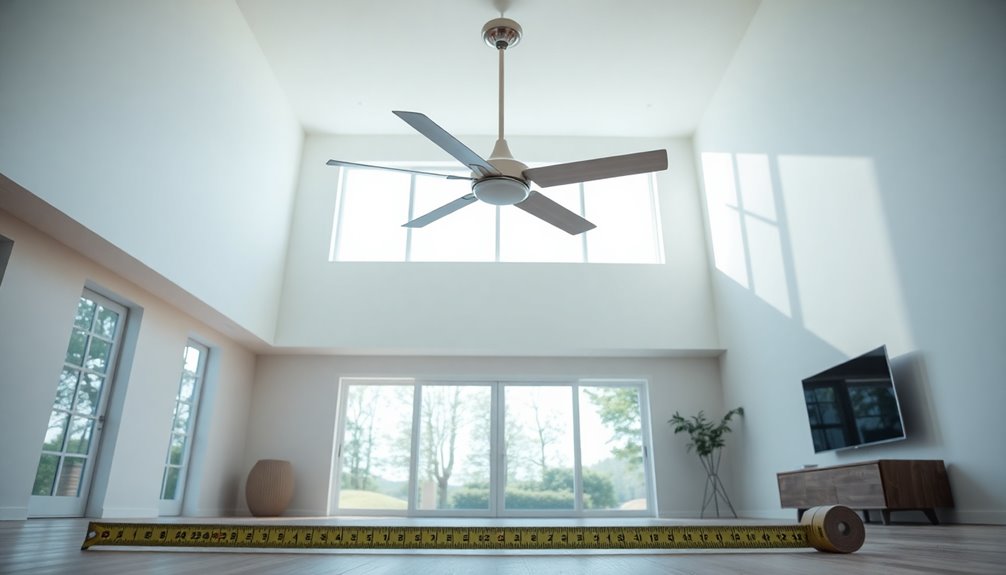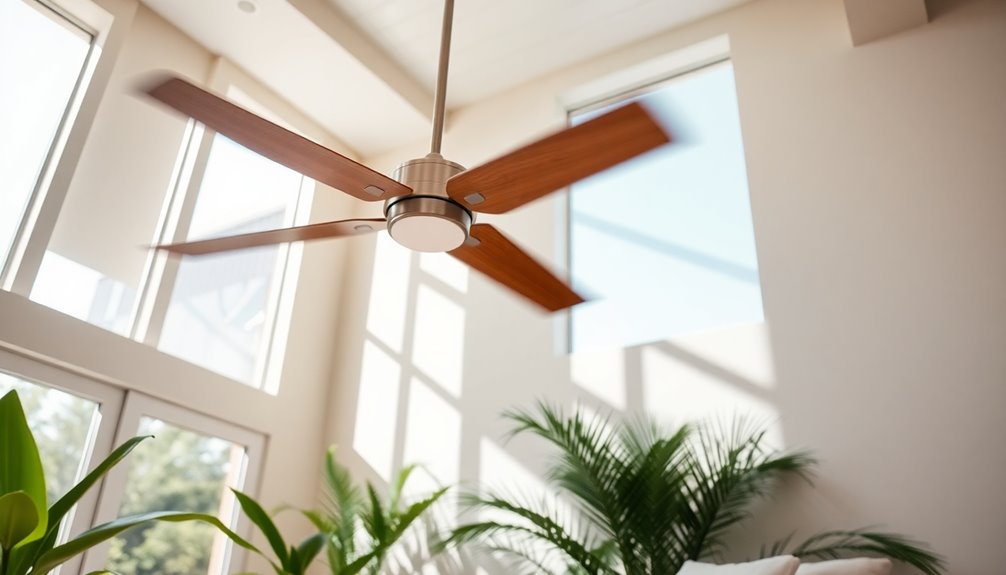If your ceiling fan is buzzing, it likely means something needs fixing. Common culprits include loose screws creating vibrations or a motor that's overworked and in need of maintenance. Misaligned blades can also contribute to the noise. Make sure to check your fan's wiring, dimmer switch compatibility, and lubrication in the moving parts. Addressing these issues not only quiets the fan but extends its lifespan, too. If you notice any unusual sounds getting worse or experience flickering lights, it might be time to call in an expert. Discover more tips on keeping your fan running smoothly and quietly.
Key Takeaways
- Buzzing often indicates electrical issues, such as faulty wiring or incompatible dimmer switches causing electrical interference.
- Loose screws or misaligned components can create vibrations, leading to buzzing noises during operation.
- Overworked motors may signal a need for maintenance or replacement, contributing to the buzzing sound.
- Blade imbalance from uneven weight distribution can cause vibrations, resulting in buzzing at high speeds.
- Regular maintenance, including cleaning and tightening screws, can help reduce or eliminate buzzing noises.
Understanding Ceiling Fan Noises

Ceiling fans can produce a variety of noises, but buzzing is one of the most common and concerning. When you hear buzzing, it's important to take it seriously. This sound often indicates potential electrical issues, like faulty wiring or incompatible control systems. If left unchecked, these problems could lead to hazards in your home.
Additionally, a buzzing noise might come from an overworked motor. Excessive use or an aging fan could cause vibrations that turn into annoying ceiling fan noise.
Don't overlook the impact of loose screws or misaligned components, either. These can create vibrations that resonate throughout the fan, amplifying the buzzing sound.
To effectively address this issue, you'll want to focus on diagnosing the problem promptly. Regular maintenance is vital; tightening connections and ensuring proper installation can help mitigate buzzing noises and enhance your fan's performance.
Common Causes of Buzzing
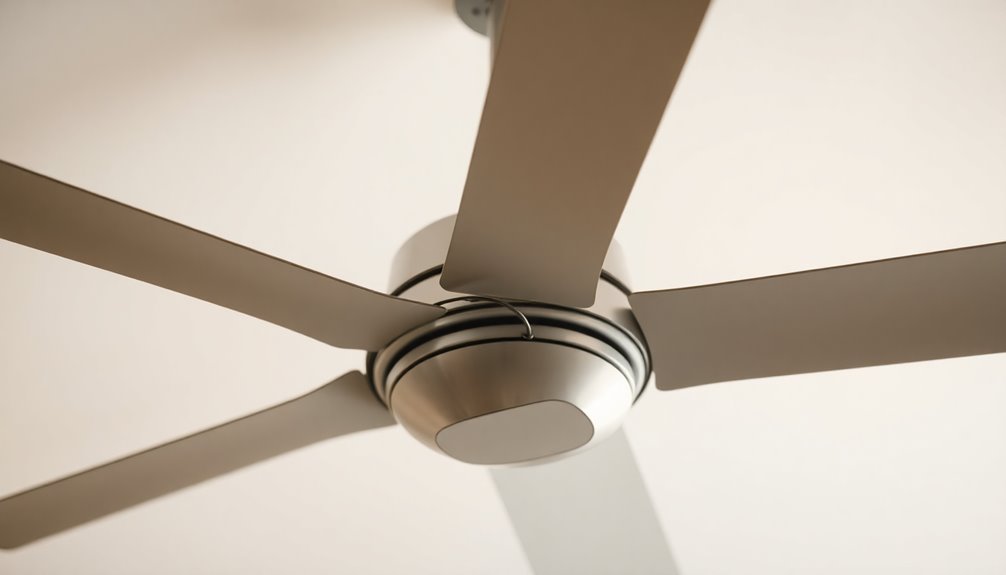
When a buzzing noise comes from your fan, it's often a sign of underlying issues that need attention. One common cause might be loose screws within the fan assembly. These loose components can create vibrations, resulting in that annoying buzzing noise during operation.
Another culprit could be an overworked motor, which often signals it's time for maintenance or even replacement. If your fan's motor is struggling, you might notice a persistent hum along with the buzz.
You should also check for incorrectly installed light fixtures attached to your fan. If the bulbs are of the wrong wattage, they can create buzzing sounds. In addition, if you're using dimmer switches that aren't compatible with ceiling fan motors, this can lead to electrical interference, causing that irritating noise.
Finally, insufficient lubrication in the fan's moving parts can produce a buzzing sound as well. Regular maintenance, including using the best oils for ceiling fans, is essential to ensure optimal performance and minimize noise.
Addressing these common causes can help restore peace and quiet to your home. If the buzzing persists, consider seeking professional assistance to guarantee your fan operates safely and efficiently.
Identifying Electrical Issues
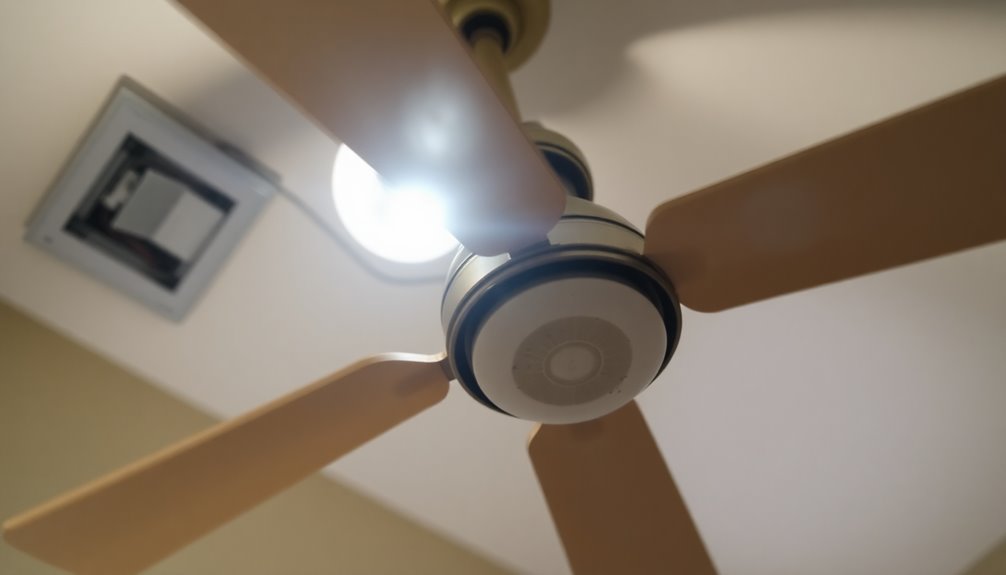
When your ceiling fan buzzes, it's essential to check for electrical issues that could be causing the problem.
Start by ensuring that the wiring is compatible with your fan and inspect any dimmer switches for compatibility.
Also, take a close look at all electrical connections; loose or damaged wires can lead to buzzing and pose safety risks.
Wiring Compatibility Check
Identifying wiring compatibility issues is vital for a smoothly operating ceiling fan. Start by confirming your fan is compatible with your home's electrical system. Incompatible fan controls or dimmer switches can lead to annoying buzzing noises.
Next, check the wattage of the light bulbs used in the fan; using incorrect wattage can cause electrical strain, resulting in those pesky sounds.
Inspect all electrical connections for any signs of wear, damage, or loose wires. Poor connections can create electrical noise, so it's important to tighten any loose wires.
Additionally, verify that the circuit breaker supplying power to the fan is functioning properly. If it's tripping or not providing a stable connection, that could cause intermittent power and contribute to buzzing.
Finally, use a voltage tester to verify the fan is receiving the appropriate voltage. Fluctuations or incorrect voltage can lead to operational issues and buzzing noises as well.
Dimmer Switch Issues
Incompatible dimmer switches can be a significant culprit behind your ceiling fan's buzzing noise. These switches often fail to provide a stable voltage supply, resulting in motor strain and a persistent buzzing sound, especially at lower speed settings. If you've noticed this noise after installing a new dimmer, it might not be suitable for your specific fan model.
| Issue | Solution |
|---|---|
| Buzzing at low speeds | Check for dimmer compatibility |
| Inadequate voltage supply | Replace with fan-rated speed control |
| Standard switch used | Install a fan-rated dimmer switch |
Using a standard wall switch instead of a dimmer switch for your ceiling fan is generally recommended, as dimmers are primarily designed for lighting, not for motorized devices. To solve the buzzing issue effectively, consider replacing your current dimmer switch with a fan-rated speed control that can properly manage the fan's operation and electrical load. This change can help eliminate the buzzing sound and enhance your ceiling fan's performance, making for a more pleasant environment.
Electrical Connection Inspection
A buzzing ceiling fan can often signal underlying electrical issues that need your attention. One common cause of this buzzing noise is loose wiring connections, which can lead to arcing and vibrations. Start by checking all electrical connections to the fan; make certain that wire nuts are tightly fastened.
Loose wiring can create incomplete circuits, resulting in that annoying buzz. Additionally, if you've installed a dimmer switch, it's essential to verify its compatibility with your ceiling fan model. Using a dimmer switch not designed for ceiling fans can trigger buzzing sounds and even damage the fan.
Another component to inspect is the fan's capacitor. A malfunctioning capacitor can cause the motor to struggle, leading to persistent buzzing during operation.
If you've checked these elements and the buzzing noise persists, it might be time to seek a professional evaluation. A qualified technician can thoroughly assess the fan's wiring and electrical components, helping to prevent potential hazards.
Don't ignore those buzzing sounds—taking action can save you from more significant issues down the road.
Blade Imbalance and Its Effects
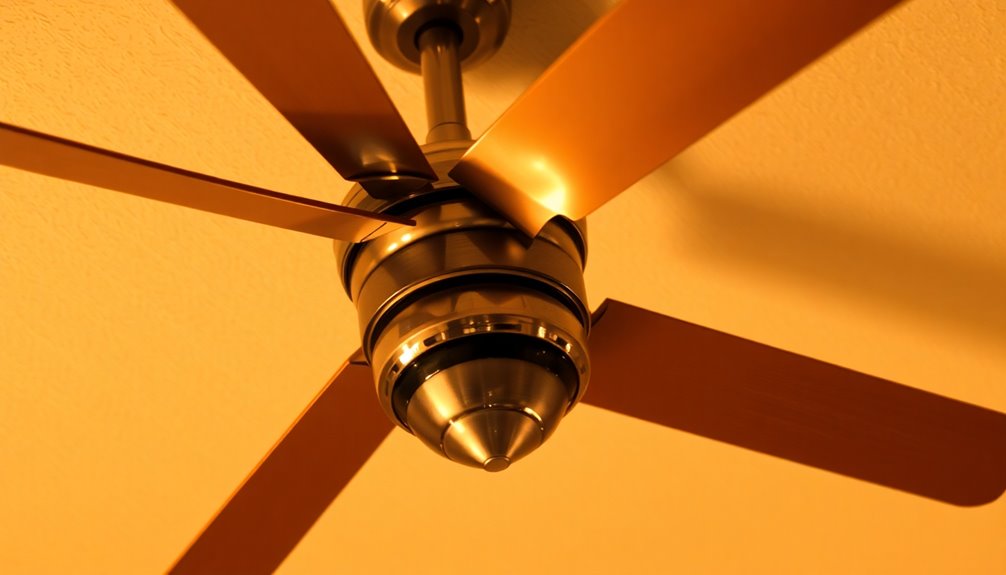
Blade imbalance often leads to frustrating buzzing noises when your ceiling fan is in use. This issue arises when the weight of the blades is unevenly distributed, causing vibrations that disrupt your peace.
Even a slight misalignment can produce significant noise as your fan struggles to maintain balance at high speeds.
To tackle blade imbalance, consider these four key points:
- Regular inspections: Check blade alignment and condition to catch issues early.
- Clean the blades: Dust and debris can worsen imbalance, so keep them clean for even distribution.
- Use a blade balancing kit: These kits help identify and fix imbalance by adding weights to lighter blades or adjusting angles.
- Prolong the lifespan: Addressing imbalance reduces strain on the motor, helping your fan last longer.
Maintenance Tips for Quiet Operation
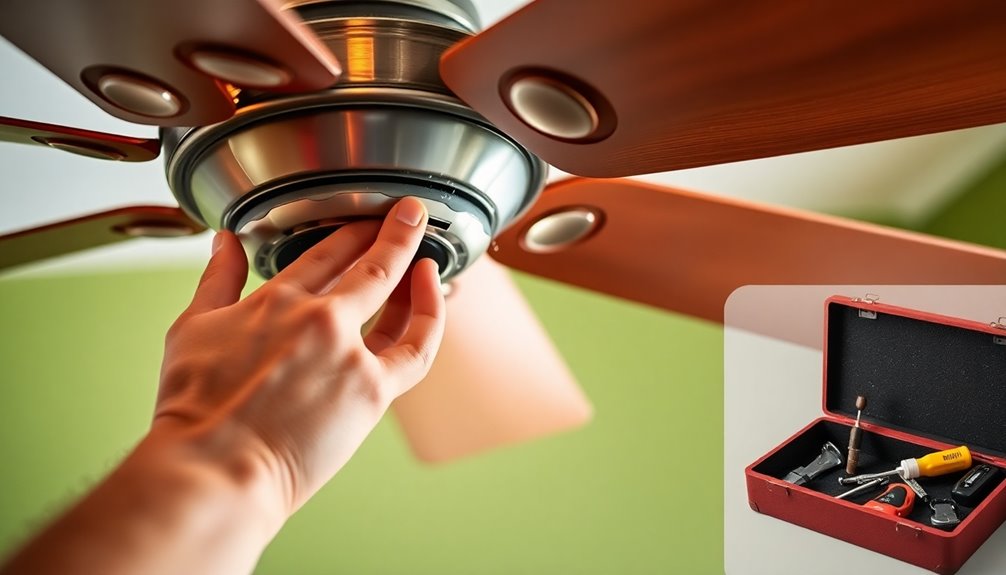
To keep your ceiling fan running quietly, regular cleaning and maintenance are essential.
Make it a habit to tighten all screws and bolts to prevent vibrations that can cause buzzing.
Also, don't forget to wipe down the blades to remove dust, ensuring smooth operation and reduced noise levels. Additionally, proper use of your fan can lead to lower energy bills as increased efficiency reduces reliance on air conditioning.
Regular Cleaning Practices
Keeping your ceiling fan clean is essential for ensuring it operates quietly and efficiently. Regular cleaning practices help remove dust and debris that can accumulate on the fan blades and motor housing, leading to increased noise levels and decreased efficiency.
To maintain a quieter function, follow these steps:
- Clean the fan blades: Use a soft cloth or a vacuum with a brush attachment to gently clean the blades at least once a month. This keeps them balanced and free from obstructions.
- Inspect the motor housing: Regularly check and clean the fan's motor housing to remove dirt and grime. Compressed air can help blow out any particles that hinder operation.
- Check the pull chain and switches: Periodically inspect and clean these components to prevent dust build-up, which can cause buzzing or humming noises.
- Establish a maintenance schedule: Include regular cleaning and lubrication of moving parts in your routine to prolong the fan's lifespan and maintain its quiet operation.
Tightening Fasteners Routine
Over time, ceiling fans can develop noise issues due to loose fasteners and screws. To prevent buzzing, it's essential to incorporate a tightening fasteners routine into your maintenance schedule.
Start by conducting regular checks of all screws and fasteners on the fan, including those on the motor assembly, blade brackets, and light fixtures. This simple step can eliminate rattling caused by loose parts.
Make certain to inspect the canopy screws that secure the fan to the ceiling. If they're not securely fastened, you might hear annoying buzzing sounds.
Don't forget to check the downrod, which connects the fan to the ceiling; a loose downrod can lead to wobbling and additional noise.
Schedule routine maintenance every few months to tighten any fasteners that may have loosened over time.
Also, verify that all electrical connections are secure and properly fastened, as loose wiring can contribute to electrical buzzing noises that may need immediate attention. Additionally, consider that maintaining your fan can enhance its energy efficiency, ensuring it operates quietly and effectively for years to come.
When to Seek Professional Help
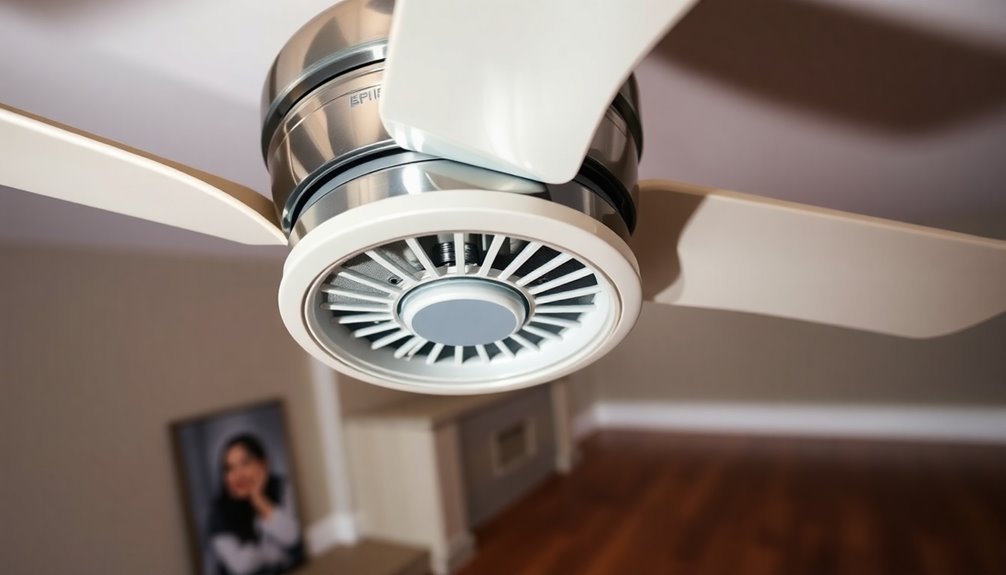
If your ceiling fan's buzzing persists despite your best troubleshooting efforts, it's time to contemplate seeking professional help. Ignoring the issue could lead to safety hazards or further damage.
Here are four signs that indicate you should call a professional electrician:
- Unusual Buzzing Noise: If the buzzing noise increases with the fan speed, it may be a failing fan motor that requires replacement.
- Flickering Lights or Tripped Breakers: These signs often point to electrical issues that need immediate attention.
- Burning Smells or Overheating Components: If you detect these alarming signs while the fan is buzzing, turn off the power immediately and contact an electrician to avoid fire hazards.
- Difficulty Balancing or Adjusting Settings: If you've tried fixing loose screws and balancing the fan but the buzzing continues, it's time to seek professional assistance.
Addressing these issues early can prevent further complications and guarantee your ceiling fan operates safely and effectively.
Don't hesitate to reach out to a professional when you notice these signs of damage; proper diagnosing and fixing are vital for your safety.
Benefits of a Quiet Ceiling Fan

Experiencing a buzzing ceiling fan can disrupt your peace, but once those issues are resolved, the benefits of a quiet ceiling fan become evident.
First and foremost, a quiet ceiling fan enhances your overall comfort by providing soothing airflow without disruptive noise. This creates a more relaxed atmosphere in your living space. Additionally, maintaining a consistent indoor temperature can significantly improve your comfort levels throughout the year. A well-functioning fan promotes energy efficiency, ensuring that your cooling system runs less frequently. Moreover, maintaining skin hydration is also important for overall comfort, especially in dry environments. The presence of energy-efficient systems can help further reduce your energy consumption.
Furthermore, reducing noise can greatly improve sleep quality. A tranquil indoor environment allows you to rest and relax without disturbances, making it easier to drift off at night. You'll find that a peaceful setting contributes to a more restful sleep experience.
Additionally, a quiet ceiling fan operates more efficiently, leading to energy savings. When your fan runs smoothly and quietly, you won't need to rely on additional cooling or heating systems as much. This efficient operation not only benefits your wallet but also extends the lifespan of the unit, minimizing costly replacements and repairs down the line. Moreover, understanding the importance of indoor air quality is essential for maintaining a healthy living space.
Ultimately, enjoying a tranquil indoor environment without the annoyance of fan noise enhances your overall enjoyment, whether you're reading, watching TV, or entertaining guests.
Embracing a quiet ceiling fan is a smart choice for comfort and tranquility.
Long-Term Solutions for Noise Reduction
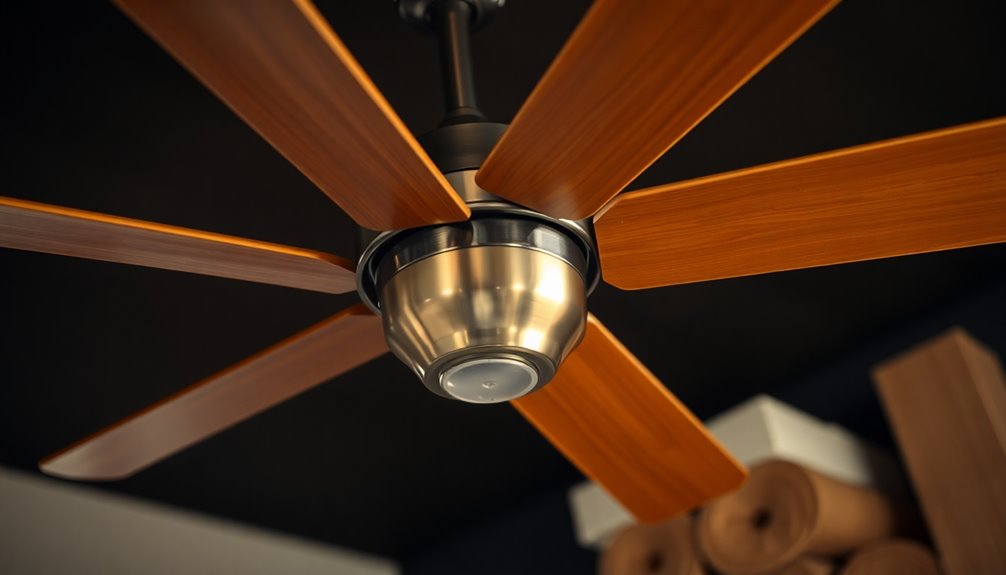
Regular maintenance is key to ensuring your ceiling fan operates quietly and efficiently. To tackle noise issues effectively, consider these long-term solutions:
- Tighten Loose Screws: Regularly inspect and secure all screws and connections. This prevents vibrations and buzzing sounds that can arise from unfastened components.
- Cleaning Blades: Dust and debris can accumulate on the blades and motor housing, leading to unbalanced blades and operational noise. Make it a habit to clean them to maintain ideal performance.
- Lubrication of Motor: Schedule an annual inspection and lubricate motor bearings to minimize friction. This simple step can greatly reduce humming or buzzing noises over time.
- Use a Blade Balancing Kit: If you notice persistent noise, invest in a blade balancing kit. This helps address any imbalances, ultimately enhancing fan performance and reducing noise levels.
Additionally, consider upgrading to compatible control systems and light dimmers. Incompatible devices can cause electrical buzzing, so ensuring compatibility can lead to smoother operation.
Frequently Asked Questions
How Do You Fix a Buzzing Ceiling Fan?
To fix a buzzing ceiling fan, start by tightening any loose screws and connections.
Check the fan blades for damage or imbalance and use a balancing kit if needed.
Verify your fan's control system is compatible, as mismatched controls can cause buzzing.
Lubricate the motor bearings annually to reduce friction.
If the buzzing doesn't stop, it's best to consult a professional electrician to check for wiring or motor issues.
Why Is My Fan Motor Making a Buzzing Sound?
If your fan motor's making a buzzing sound, it's likely due to electrical issues or an overworked motor.
You might've incompatible controls or faulty wiring, which need attention. Sometimes, dust and grime can cause friction, making the motor struggle.
Check for any misalignment or worn-out components. Regular maintenance, like lubricating bearings and inspecting connections, can help reduce noise and extend the lifespan of your fan.
Don't ignore those sounds!
How Do I Eliminate the Buzzing Noise in a Ceiling Fan When It Runs on an Inverter?
Did you know that nearly 30% of ceiling fan issues stem from electrical connections?
To eliminate buzzing noise when your ceiling fan runs on an inverter, start by checking the inverter's compatibility with your fan's power requirements.
Tighten any loose electrical connections, and verify the fan's speed control is appropriate.
Additionally, maintain and lubricate the motor to reduce friction.
Investing in a quality inverter can also help provide stable power and minimize noise levels.
Why Is My Ceiling Buzzing?
If your ceiling's buzzing, it could be due to electrical interference or loose connections.
Check for any appliances nearby that might be causing the noise. You should also inspect for loose wires or connections in the ceiling, as these can create vibrations that lead to buzzing sounds.
Dust accumulation can also contribute to the noise, so cleaning the area might help.
Addressing these issues can quiet that irritating buzzing.
Conclusion
To sum up, a buzzing ceiling fan can be more than just annoying; it often signals underlying issues. Did you know that nearly 30% of ceiling fans experience noise problems at some point? By addressing these issues early, you not only enhance your comfort but also extend your fan's lifespan. Don't hesitate to follow maintenance tips or reach out for professional help when needed. Enjoy the peace and tranquility of a quieter space with a well-functioning ceiling fan!




